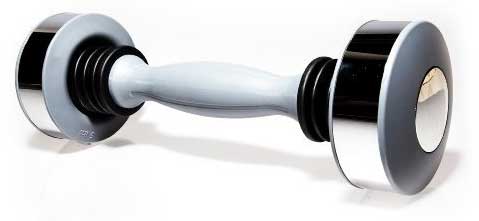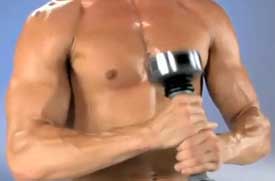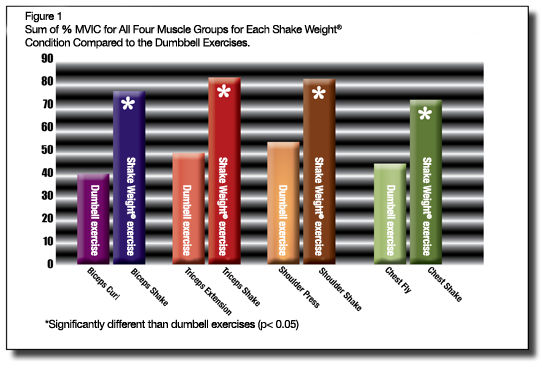
BY MARK ANDERS WITH JENNAH HACKBARTH, M.S., JOHN P. PORCARI, PH.D., THOMAS KERNOZEK, PH.D., SCOTT DOBERSTEIN, M.S., TIMOTHY SUCHOMEL, B.S., AND CARL FOSTER, PH.D.
“Shake Weight is the flab-busting breakthrough that trims your arms and shapes your shoulders at the same time.”
“With the Shake Weight you can get firm and fabulous arms and shoulders in just six minutes a day for only $19.95.”
Hitting the infomercial airwaves in 2009 with promises like these, Shake Weight quickly became one of the hottest-selling products on TV. Originally marketed to females as the cure for flabby arms, the Shake Weight is essentially a lightweight 2.5-pound dumbbell with springs on either end that is designed to be held with one or both hands and shaken back and forth vigorously in a limited range of movement. This rhythmic motion produces an isometric workout for the upper body that, according to the infomercial, enables the Shake Weight “to increase your upper-body muscle activity by up to 300 percent compared to some traditional weights.”

Laughing All the Way to the Bank
Over the past couple of years, the Shake Weight infomercials have gained something of a cult following in popular culture, primarily because some find that the way the models use the Shake Weight in the infomercial can be perceived as sexually suggestive. In fact, many television comedians and shows have done risqué Shake Weight spoofs, including Saturday Night Live, Ellen DeGeneres, The Daily Show, and even the animated TV show South Park. A quick YouTube search yields several very funny parodies. But officials at Fitness IQ say they don't mind the parodies and insist that these parodies probably have, in fact, helped to make the Shake Weight one of the best-selling fitness products in the nation.
Better results in less time? It may sound too good to be true, but the buying public is, well, buying it. In its first year on the market, the Shake Weight sold more than 2 million units and has since surpassed the 4.5 million mark. A heavier, 5-pound version was also introduced for men and began selling briskly as well. In fact, Fitness IQ founder and Chief Executive Johann Verheem, the maker of Shake Weight, predicts the product will go on to sell 10 million units in its lifetime on TV. The Shake Weight is now also sold in stores like Walmart and Walgreens, where it is one of the best-selling fitness products on their shelves.
The infomercials attempt to silence doubters by citing “independent” scientific studies: “A world leader in biomechanics showed it burns muscle energy and calories over five times faster than a dumbbell—this means a workout that takes 32 minutes with traditional dumbbells takes only six minutes with the Shake Weight...Shake Weight is science fact, not fiction."
Based on consumers’ growing interest in the Shake Weight, the American Council on Exercise, the nation’s Workout Watchdog, commissioned a team of exercise scientists from the University of Wisconsin, La Crosse, to evaluate the degree of muscle activation when using the Shake Weight versus a traditional dumbbell of equal weight.
The StudyLed by John Porcari, Ph.D., and Jennah Hackbarth, M.S., a team of researchers from the University’s Departments of Exercise and Sport Science and Physical Therapy recruited 16 healthy volunteers, both male and female, between the ages of 18 and 30 years old. Prior to testing, each of the subjects completed three practice sessions on three separate days to become well acquainted with using the Shake Weight. After learning the proper grip and use of the device (women used the 2.5-pound device, while men used the 5-pounder) each followed the official six-minute Shake Weight DVD workout that comes with the product. The short video leads subjects through four different exercises including the one-handed biceps shake, two-handed triceps shake, one-handed shoulder shake and two-handed chest shake. Each set lasts 15 seconds (30 seconds for men) and is followed by a two-minute rest period. All four exercises would later be replicated during the actual exercise testing alongside four equivalent common exercises, including the biceps curl, triceps extension, shoulder press and chest fly, using an equally weighted traditional dumbbell (2.5 pounds for women, 5 pounds for men).
To measure the muscle activity during each exercise, researchers used surface electromyography (EMG). Recordings were collected from four muscles during each of the eight exercise tests, with electrodes placed on each subject’s biceps, triceps, deltoid and pectoralis muscles. Following each exercise, ratings of perceived exertion (RPE) were also recorded using the Borg 6-20 scale to determine how intensely the subjects felt they were exercising.
The ResultsAfter crunching the numbers and data, researchers found that, across the board, the total EMG activity for all four muscles was significantly greater for the Shake Weight exercises compared to the traditional dumbbell exercises. In fact, on average, total muscle activity was 66 percent greater when performing Shake Weight exercises.
Specifically, the total muscle activity was 88 percent greater when performing the biceps shake compared to the biceps curl; 65 percent greater for the triceps shake versus the triceps extension; 50 percent greater when performing the shoulder shake compared to the shoulder press; and 59 percent greater for the chest shake versus the chest fly (Figure 1).

The subjects’ ratings of perceived exertion were also significantly higher for the Shake Weight—approximately 12.0 RPE compared to 9.3 for the dumbbell exercises. "I think a lot of the subjects, especially the males, didn’t expect the Shake Weight to be as tough as it actually was," says researcher Jennah Hackbarth, M.S. “We’d be telling them to shake the weight as rapidly as they could, and a lot of them were turning really red in the face.”
However, it is important to note that the increased muscle activation in this study was markedly lower than the EMG data touted on the infomercial (a 66-percent increase versus the 300 percent that the Shake Weight ad claims). The ACE-sponsored research team contacted the researcher who conducted the testing for Shake Weight, but he stated that he was not at liberty to share the data.
Another interesting finding was that while there was significantly greater muscle activation in the Shake Weight exercises, the highest EMG values were usually not from the targeted muscle. In nearly every Shake Weight exercise tested, the triceps appeared to be working just as hard, if not harder, than the targeted muscle for each exercise. For example, during the biceps shake, the triceps was activated the most out of all four muscles evaluated. In fact, the muscle activation in the triceps was approximately 60 percent higher than the biceps muscle activity during the biceps shake.
“The muscles the Shake Weight exercises are supposed to target are not always the ones targeted,” says Porcari. “For example, during the biceps shake, the muscle working hardest was the triceps because it’s providing the braking force, a co-contraction. And during the pectoralis exercise, the triceps is working the hardest."
The Bottom LineWhile the Shake Weight does indeed show more EMG activity, Porcari warns consumers to be sure to compare apples to apples when looking at this type of research. “Sure, it’s better than a two-and-a-half-pound dumbbell, but who goes to a gym and lifts two-and-a-half-pound dumbbells?” he quips.
“If you put forth effort, the Shake Weight, because it provides some level of resistance will produce an exercise response, particularly for individuals at the low end of the fitness spectrum,” further explains Cedric X. Bryant, Ph.D., and ACE's chief science officer. “For a person who has experience with resistance training, however, it’s probably going to have, at most, a modest effect. But for a person who is unaccustomed to resistance training, the law of initial value applies. In other words, if you’re not used to doing anything, just about any dose of exercise is going to have some positive effect.”
That said, it’s also important to note that the Shake Weight is basically an isometric exercise with vibrating tension that occurs in a very limited range of motion. So while you may gain some strength and endurance with the Shake Weight, those benefits would likely only be noticeable over a narrow range of motion. That begs the question: Exercise for what purpose? What is the true carryover benefit of the Shake Weight into real-life function?
Not much, says Porcari. “There aren’t that many things you do in daily life where you just shake the heck out of something. Really what benefit is that movement? Maybe if you’re shaking up a can of spray paint and you have to dislodge that little agitator ball at the bottom. And there might be some carryover to holding something close to your chest, but we do most things in everyday life through a full range of motion.”
Based on the RPE data, there’s no doubt that many exercisers will feel initially quite fatigued from using the Shake Weight. Researchers warn, however, that the physical sensations you feel aren’t always reflective of the true impact or value of an exercise. “Of course you’ll be sore, because it’s not something your body is used to—it's working your muscles in a different way,” explains Hackbarth.
Bryant asserts that while the experts at ACE are always hesitant to pan any exercise product that gets people up off the couch and moving (doing something is always better than not exercising at all), he also stresses the importance of taking advertising claims, like those made by Shake Weight, with a grain of salt.
“Its greatest value is probably limited to a very select audience,” he says. “The consumer needs to understand that if you’re engaged in a normal resistance-training program, this is likely not going to be the magic bullet to put you over the top.”
_______________________________________________________________
 MARK ANDERS is an award-winning journalist who has covered a wide range of topics from rock star profiles to surfing river waves in Africa. His work has been published in more than 20 different magazines and books.
MARK ANDERS is an award-winning journalist who has covered a wide range of topics from rock star profiles to surfing river waves in Africa. His work has been published in more than 20 different magazines and books.